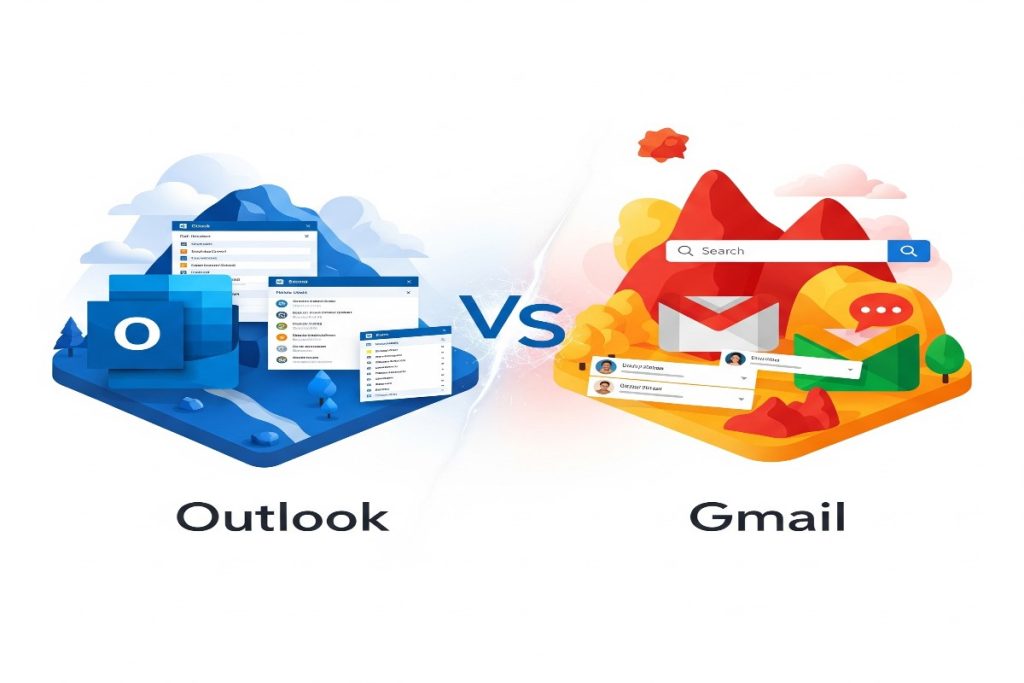Introduction
When it comes to handling work-related emails, two names stand out in the global discourse: Outlook and Gmail. These platforms are not merely inboxes; they have transformed into comprehensive productivity ecosystems that influence how professionals communicate, collaborate, and maintain organization. From scheduling meetings and managing documents to integrating with project management applications, both services strive to serve as your all-encompassing workspace.
However, if you find yourself deciding between the two, which one genuinely provides you with a competitive advantage in your professional endeavors? This comparison of Gmail and Outlook carefully looks at features, usability, security, and integrations, weighing the advantages and disadvantages of each so you can choose the one that best suits your needs.

A Quick History of Outlook & Gmail
Microsoft Outlook has existed since the mid-1990s, transforming from a basic email client into a comprehensive business communication platform. With deep connections to Microsoft Office and now Microsoft 365, it has become a fundamental tool in corporate settings.
Gmail, introduced in 2004 by Google, changed the email landscape with its streamlined interface, effective search capabilities, and substantial free storage. While Outlook is grounded in enterprise productivity, Gmail has consistently prioritized user-friendly efficiency. Over the years, both platforms have broadened their features, intensifying the competition between Outlook and Gmail.
Interface & User Experience: Which Feels Faster?
With the well-known folder tree on the left, emails in the middle, and the preview window on the right, Outlook’s interface tends to resemble traditional desktop layouts. Longtime business users who like familiarity adore this design.
In contrast, Gmail is more configurable and minimalistic. To cut down on clutter, the tabbed inbox automatically sorts emails into Primary, Social, and Promotions categories. Outlook’s desktop software is superior at handling offline work, while Gmail’s web-based design seems lighter if performance is a major concern.
Email Search & Organization: Labels vs. Folders
The way that Outlook and Gmail arrange emails is one of the main functional distinctions between the two programs. Outlook lets you transfer messages into specific locations by using folders. Because Gmail use labels, an email can exist in more than one category without being duplicated.
Gmail’s Google-powered search bar is incredibly quick when it comes to searching, frequently retrieving results in milliseconds. Though it can be a little slower with huge inboxes, Outlook’s search is also quite strong, particularly with filters and sorting options.
Integration with Other Tools Who Does It Better?
Outlook naturally integrates with Microsoft Teams, Word, Excel, PowerPoint, and OneDrive. For companies already in the Microsoft ecosystem, this seamless connectivity is a major advantage everything from scheduling a Teams meeting to attaching a OneDrive file happens without leaving your inbox. It’s built for those who value a centralized, corporate-grade environment where email, calendar, and file management live under one roof.
Conversely, Gmail works flawlessly with Google Workspace applications such as Google Docs, Sheets, Slides, and Meet. Its collaboration features are especially strong multiple people can edit the same document in real time, chat alongside the file, and jump into a Google Meet call without breaking flow. Gmail also supports hundreds of third-party add-ons and extensions directly from its interface, making it easy to customize your workspace to match your exact needs.
In short, the Outlook vs Gmail winner here depends on which productivity suite your work already relies on. If your organization is Microsoft-heavy, Outlook feels like home. If you thrive in a more collaborative, cloud-native environment, Gmail might be your perfect match. And if you’re a freelancer or hybrid worker? The real power could come from mixing both worlds.
Security & Privacy: Which One Protects You More?
An important consideration for work communications is security. Outlook provides multi-factor authentication, enterprise-grade encryption, and sophisticated phishing protection.Furthermore, Gmail provides notifications for suspicious activities, utilizes AI-based spam filtering, and ensures strong encryption.
The problematic part comes with privacy. Although Google says it no longer examines emails for ad targeting, Gmail’s advertising mechanism has already sparked concerns. Outlook is marketed by Microsoft as a privacy-first platform, which may appeal to businesses that are concerned about security.
Productivity Hacks Unique to Each Platform
- Outlook:
- Schedule emails to send later.
- Use Quick Steps to automate repetitive actions.
- Easily incorporate your to-do list and calendar into your email.
- Schedule emails to send later.
- Gmail:
- Smart Compose predicts your sentences to save time.
- Use filters and labels to automatically organize incoming messages.
- You may read and compose emails in offline mode without having to connect to the internet.
- Smart Compose predicts your sentences to save time.
Ultimately, the right productivity hacks can tilt the Outlook vs Gmail decision in your favor based on how you prefer to work.
Conclusion
Outlook is a logical choice for anyone who uses Microsoft products on a daily basis. It’s difficult to top Gmail if you appreciate Google Workspace’s speed, ease of use, and integration capabilities. Both are great for business use, but which one you choose will rely on your workflow, security needs, and team collaboration tools.
The correct email platform is only one component of the jigsaw for professionals navigating the modern workplace, particularly those who work remotely. Tools like Outlook or Gmail can become your everyday productivity companions when you use platforms like Wiraa, a global remote job platform.




